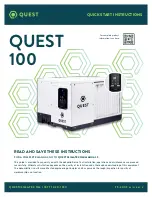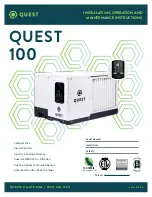
07-00283 C 12-02 Copyright 1999, Dri-Eaz Products, Inc.
5
Rotor Drive
The rotor is turned by a small drive motor and belt. A
spring-type tensioner automatically adjusts the belt tension.
DriTec 150 Controls
The DriTec 150 is controlled by an on-off rocker switch
on the front panel. The switch is lighted red with the unit is
on and operating.
DriTec 325 Controls
The controls for the DriTec 325 are located on the front
panel. The main power switch has three positions:
On –
DriTec Desiccant operates continuously.
Off
– Control system turned off. When the switch is turned
to Off after the unit has been running, the blower and drive
motor continue to run for 5 minutes to cool down the unit.
Then the unit automatically shuts off the blower and drive
motor.
Option –
Provided only for use with a remote dehumidi-
stat which is not included with this unit.
Indicator Lights (DriTec 325 only)
The DriTec 325 has four indicator lights located on the front
panel:
Power Light –
On when power to the unit is connected.
Unit On Light –
On when main switch is turned to On or
Option, and the unit is operating.
Blower On Light –
On when main switch is turned to On;
shows that the blower is operating. Stays on during cool-
down period after switch is turned off (about 5 minutes)
while blower and drive motor continue to operate until au-
tomatic shut-off. Turns Off if the blower circuit is over-
loaded and open.
Heater On Light –
On when main switch is turned to On;
shows that the heater is operating. Like the blower light,
stays on during the 5-minute cool-down period. Turns Off
if the heater circuit is overloaded and open.
Heating System
The heating system uses unique PTC-heating elements
which eliminate the need for conventional components for
temperature control and thermal safety. (PTC means positive
temperature coefficient; the element is a ceramic semi-
conductor.) These elements have a self regulating feature
which controls the output of the elements based on the re-
quired temperature. For instance, if the reactivation airflow
is reduced, the heater elements will react rapidly to the high-
er temperature with an increasing electric resistance, and
automatically reduce the heat output. An overheating protec-
tion thermostat is therefore not needed.
INSTALLATION & STARTUP
Inspection
When the unit arrives, check immediately for signs of
shipping damage. If you do notice any damage, report it to
the shipping company immediately. Notify Dri-Eaz Prod-
ucts, Inc. about the damage as soon as possible. If the unit is
damaged, do not discard the original packaging.
Positioning the Dehumidifier
The dehumidifier should be operated in a "closed sys-
tem" to achieve maximum efficiency. That is, all doors,
windows and other openings to the outside should be closed
tightly, with the exception of an opening for the reactivation
outlet (wet air) duct.
Locating the Dehumidifier
There are two options for locating the dehumidifier. Typ-
ically, it will be placed directly in the humid environment.
This allows the process air to be drawn from that area, dried,
and then returned to the same room.
In other cases, place the dehumidifier in a separate area
and duct the dry air to the damp area, for example, when
attempting to dry an attic or a crawl space under a building.
Operate the dehumidifier inside the building and duct the dry
air directly into the attic or crawl space.
When drying an area with no inside access, it is some-
times possible to vent dry air through a heat or ventilation
register opening. To do this, direct the process air duct into a
register and temporarily disconnect any ducting so the dry
air is released into the area to be dried.
The DriTec has two process output vents. This allows
ducting into two areas at one time, or leaving one vent open
to the room while ducting the other to a second area.
Air Intake Clearance
Allow at least 7" clearance between the air intake (on the
back of the unit) and any wall. Never allow any materials,
such as draperies, to obstruct the air inlet or outlets. This
could cause the unit to overheat and result in a fire or elec-
trical hazard.
Air Circulation
A desiccant dehumidifier operating in an area such as a
basement will have little effect in drying an adjacent en-
closed area, such as a closet, unless there is adequate circula-
tion of air in and out of the adjacent area. Open interior
doors and operate Dri-Eaz TurboDryers to maintain good air
movement. Doors may need to be braced to prevent them
from closing as a result of air movement. In the case of indi-
vidual rooms being dried, all doors and windows should be
kept closed.
There are times when you will want to use special tech-
niques to reduce the volume of airspace to be dried. These
techniques will be advantageous when drying dense materi-
als such as hardwood flooring. They are especially helpful
when these materials are located in a high air volume struc-
ture such as a gymnasium. The basis of this technique is to
reduce the amount of air space around the wet materials so
the volume of air to be dried is reduced.
One method is to make a plastic tent over the wet materi-
als, then direct the dry process air under the plastic tent. Use
4-6 mil plastic taped over the area. Leave two openings: one
for the process airflow and another opening on the opposite
side for damp air to escape. The amount of airspace between
the surface of the wet materials and the plastic will vary de-
pending on the size of the area. The wet materials are dried
while minimizing dehumidification and energy use.





























